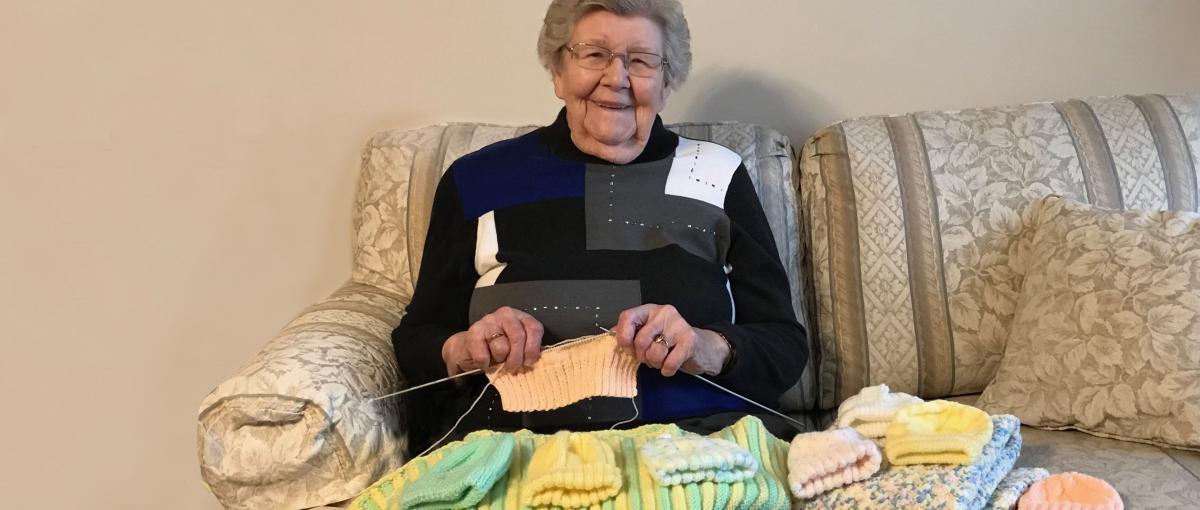Giving the gift of warmth
Volunteer Margaret Van Andel knits hats for babies at Misericordia Community Hospital

January 3, 2019
By Shelly Decker, Storytelling and Social Media Manager, Covenant Health
On a cold winter day, Margaret Van Andel is sitting in her cozy Edmonton home doing what she’s been doing for more than eight decades: knitting.
The 89-year-old, who’s been knitting since she was five, has clocked more than 9,000 volunteer hours at the Misericordia Community Hospital, most of them for the tiny hats she knits for newborns who need a little help staying warm.
“I always have some knitting on the needles. I want to keep busy with my hands,” she says.
Over the years, her gifts, ranging from newborn outfits to blankets, have been dedicated to the Misericordia, a hospital that holds a special place in her heart. It’s where 60 years ago she delivered her daughter, Marian, who was the hospital’s New Year’s baby.
Over the years, the family’s affinity for the hospital has only grown. Marian, now Marian Rasmussen, trained to be a registered nurse at the Misericordia School of Nursing and has been working at the hospital on various units for the past 38 years.
“I was born there, trained there and had all my kids there. You could say my family has a heritage at the Misericordia Hospital,” says Marian. “I remember when I was 10 years old, they were building the new Misericordia and we were driving by. I saw a nurse walking across the front lawn with her white uniform and cape and I thought, ‘I want to be a nurse at that hospital.’”
Marian was working in maternity when she suggested her mother knit for babies.
“Marian said, ‘Mom, if you want to knit, knit some hats for the babies. They are short there,’” recalls Margaret.
“If I want to knit something, I want a purpose.”
Much has changed from the time Marian was born early on New Year’s Day in 1959. Margaret, already a week overdue with her second child, wasn’t feeling well. Her husband, Case, who passed away in 2013, looked at threatening skies and opted to take her to the hospital in case a storm was coming. As was typical for the ‘50s, he dropped her off and then headed home to their farm near St. Albert to care for their two-year-old daughter.
The family didn’t have a phone and had left a neighbour’s number in case there was a problem. The next day, Case heard the news on the radio that at 2:02 a.m. on New Year’s Day, eight-pound, eight-ounce Marian had entered the world. As gifts, the couple received a nursery lamp—which Marian still has—along with a $1 coupon for children’s shoes and a diaper service for two weeks.
The family, recent immigrants from the Netherlands, were startled by the differences in childbirth in their new country. In Edmonton, an average mom stayed in hospital for five to seven days, and fathers—who weren’t allowed in the delivery room—could see their babies through a glass wall when they came for a visit. Babies were mainly kept in nurseries except to feed. But back home in the Netherlands, midwives helped deliver babies in the family home and the entire family was actively involved in helping tend a baby, recalls Margaret.
“That’s why everything was so strange to us,” she says.
In a sense, she feels that today’s delivery experience, with the exception of the hospital environment, is more like her home country. Margaret is happy that the delivery room is open to family and friends and that partners don’t need to leave. The senior is also a fan of having a baby kept in the room with a mom.
“The hospital rooms are made so nice. It feels like home, and even the grandparents are allowed to come now.”
Margaret, who used to knit hundreds of hats a year for newborns, isn’t as fast a knitter as she once was. But she wants to continue volunteering as long as she can. “I knit every week.”
Marian knows what she’ll do when the time comes that her mother no longer knits for the babies.
“When she doesn’t, I will,” says Marian. “I would like to keep up this tradition.”